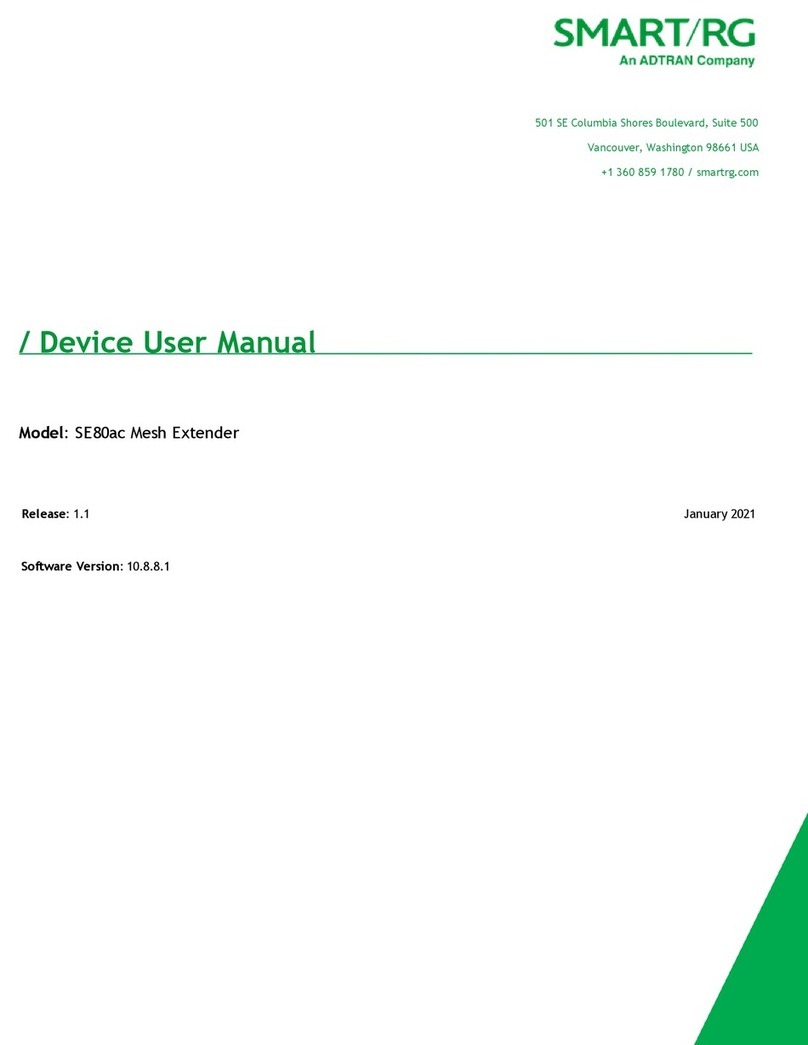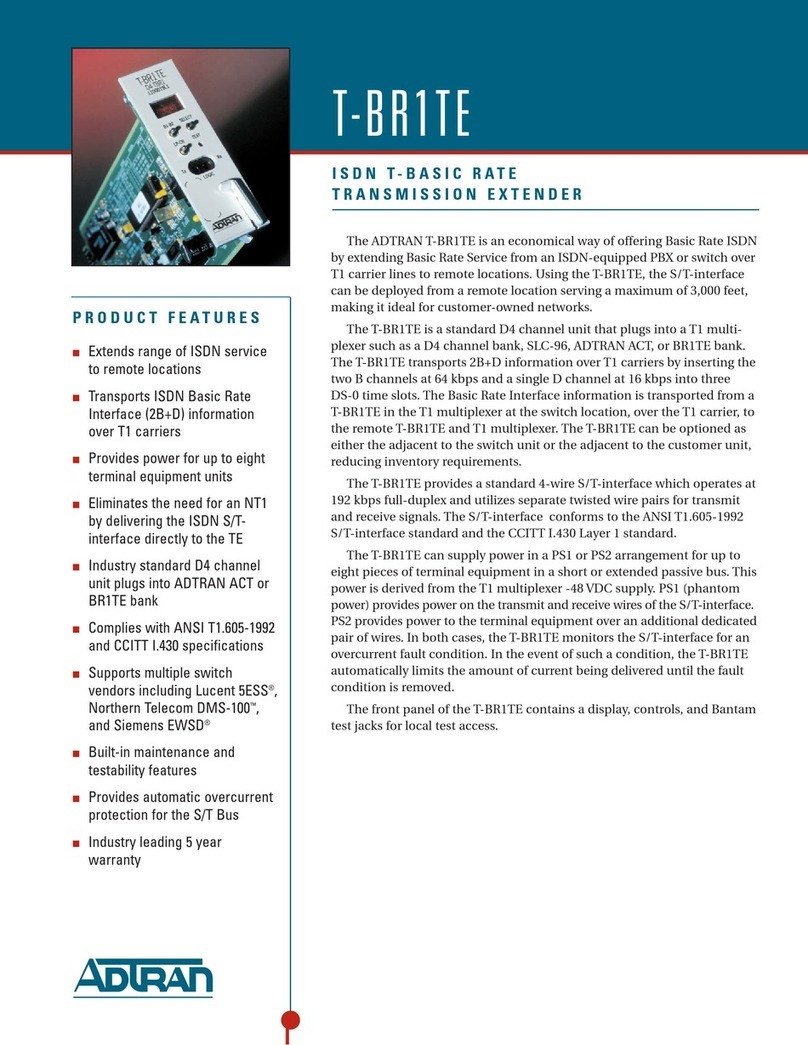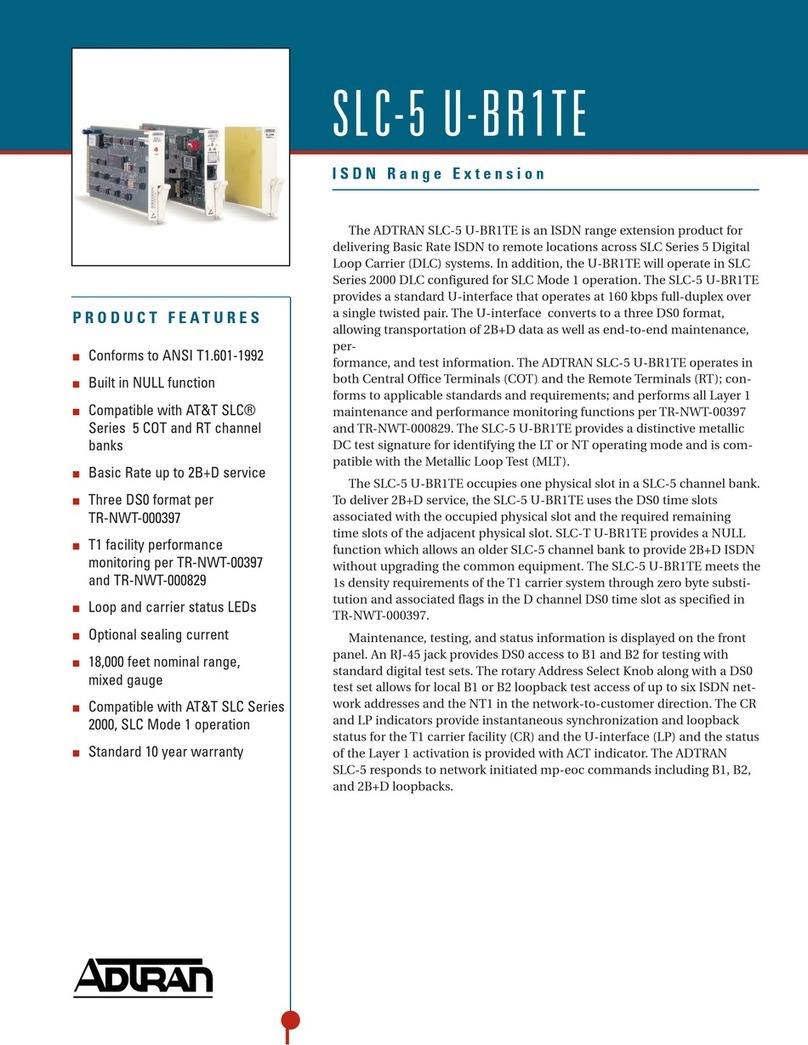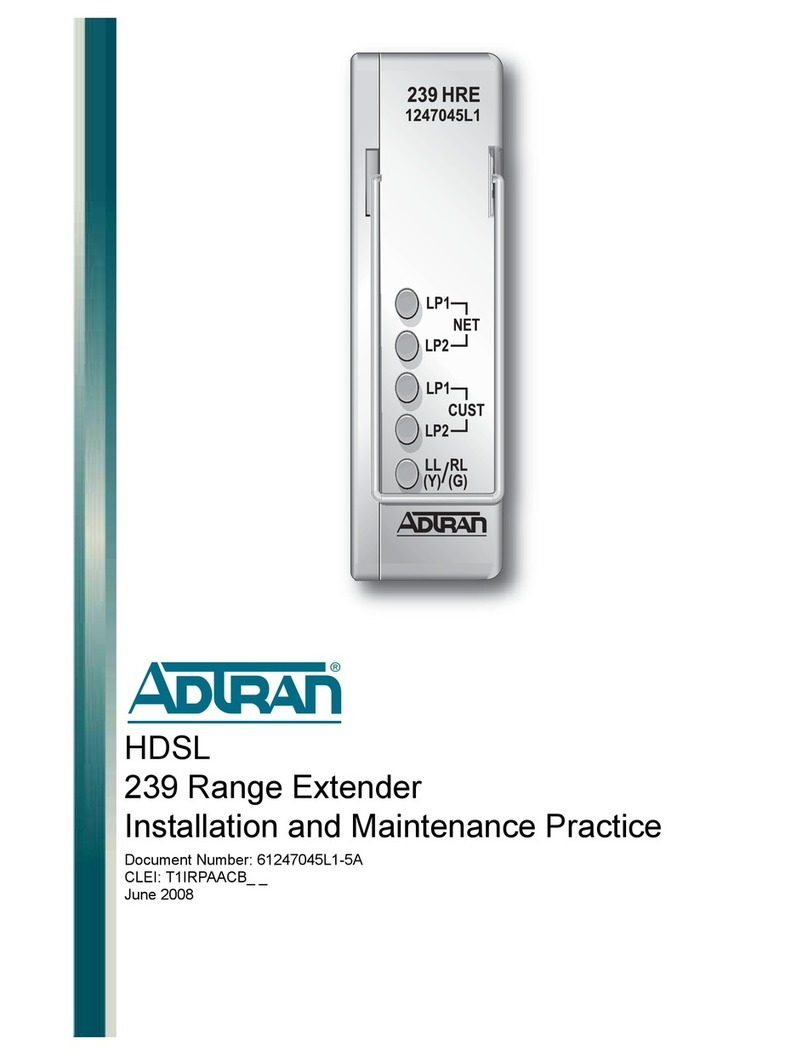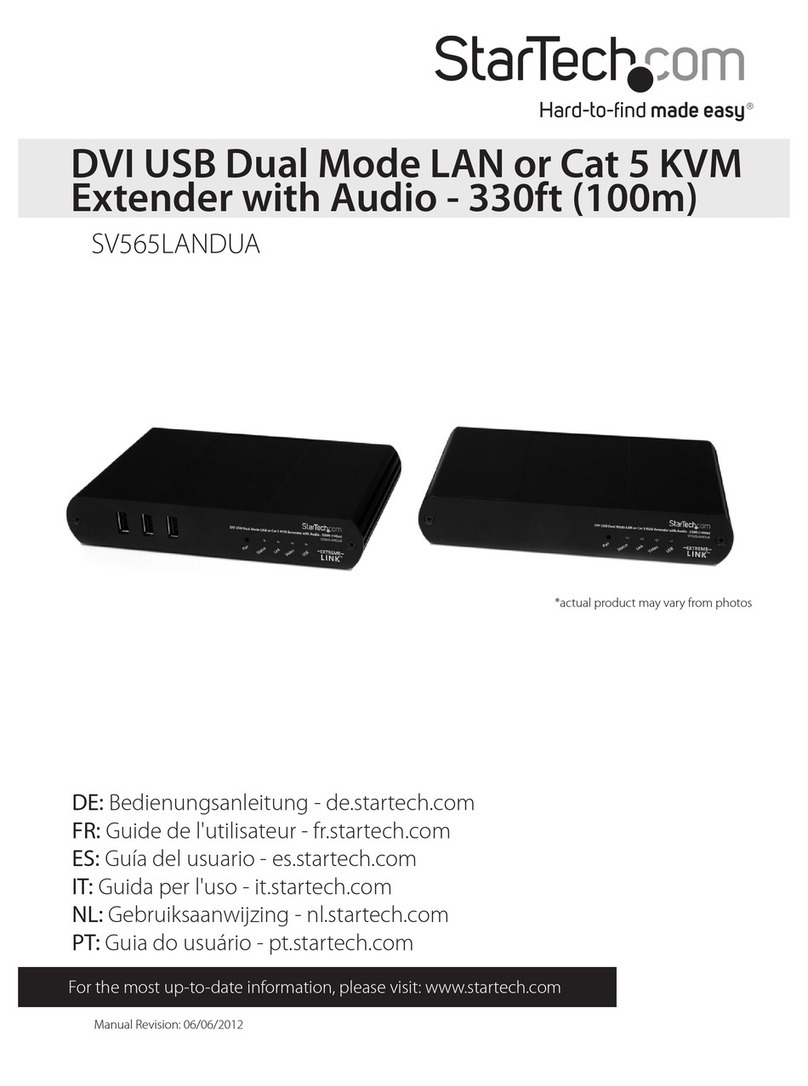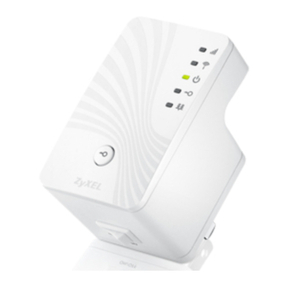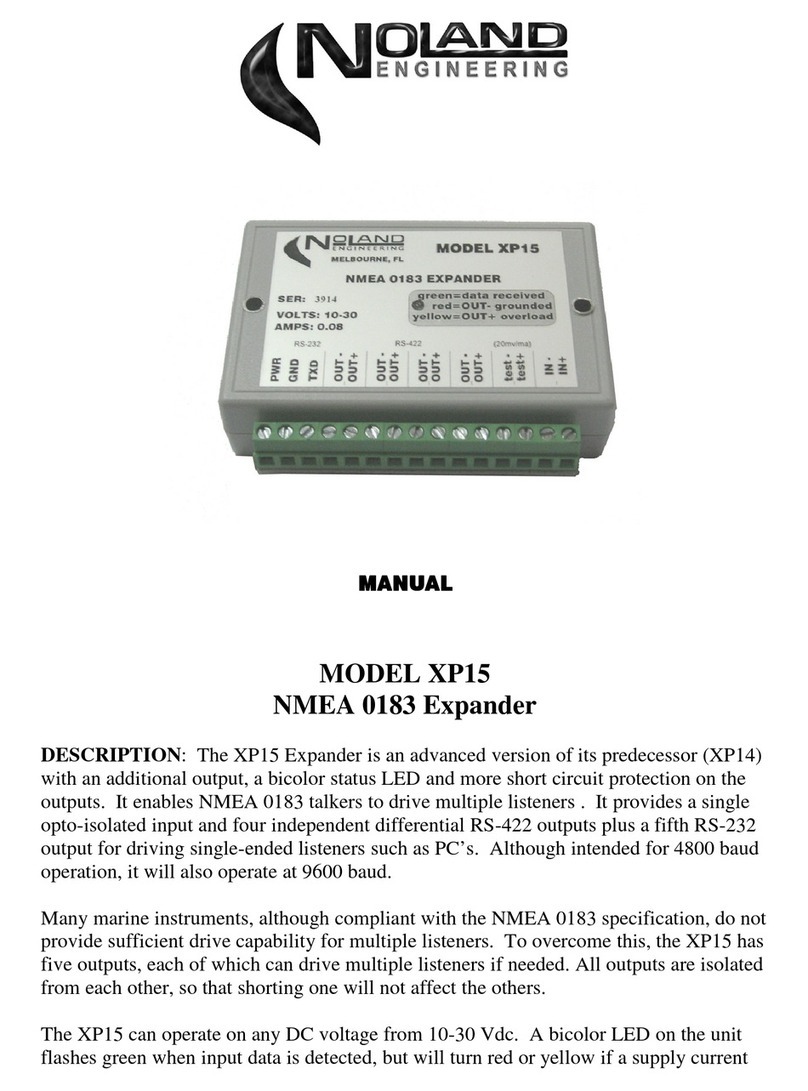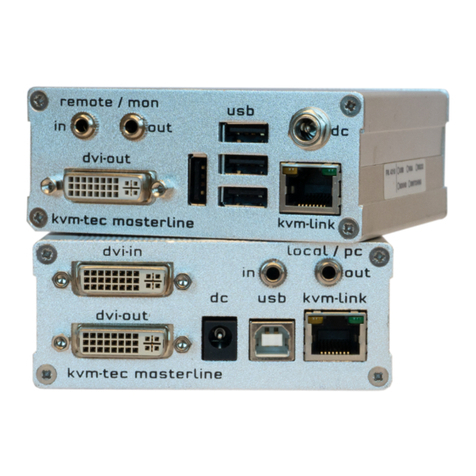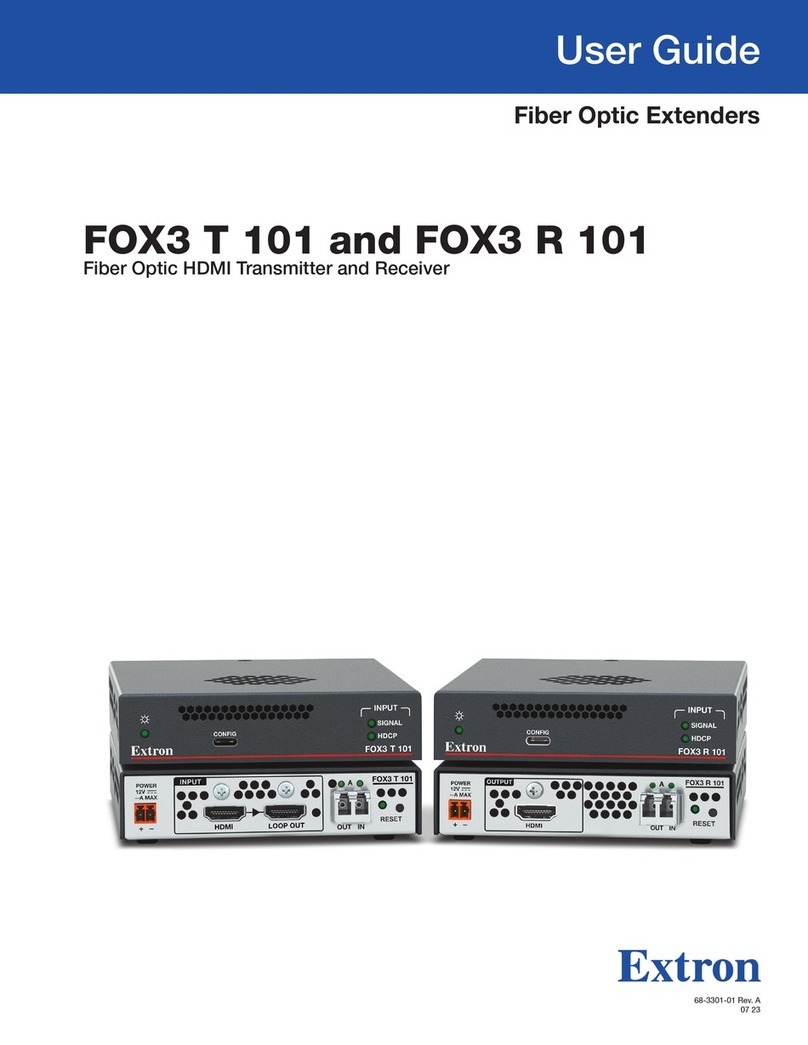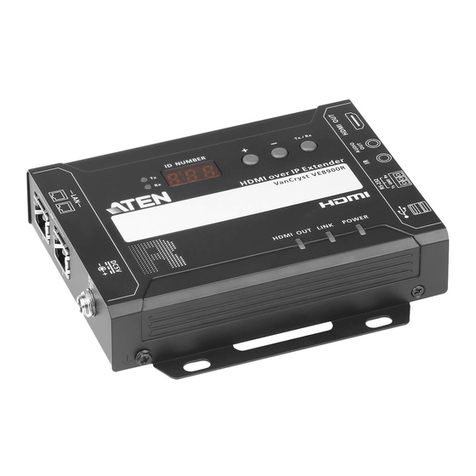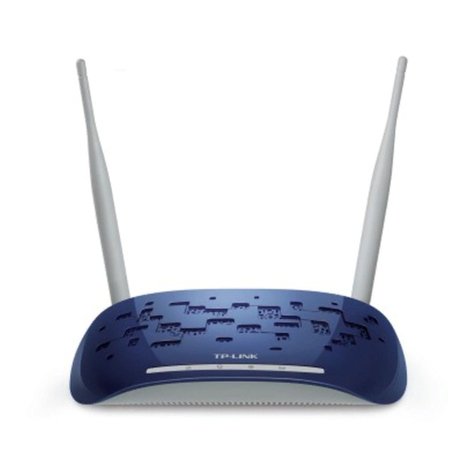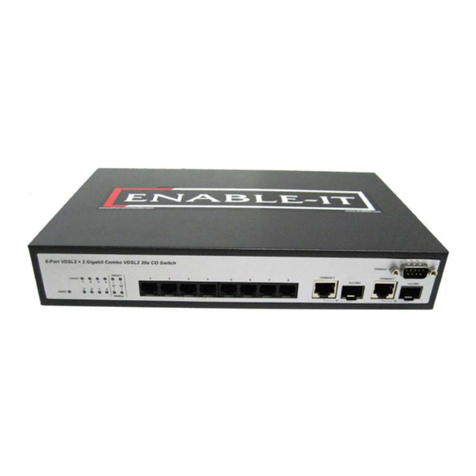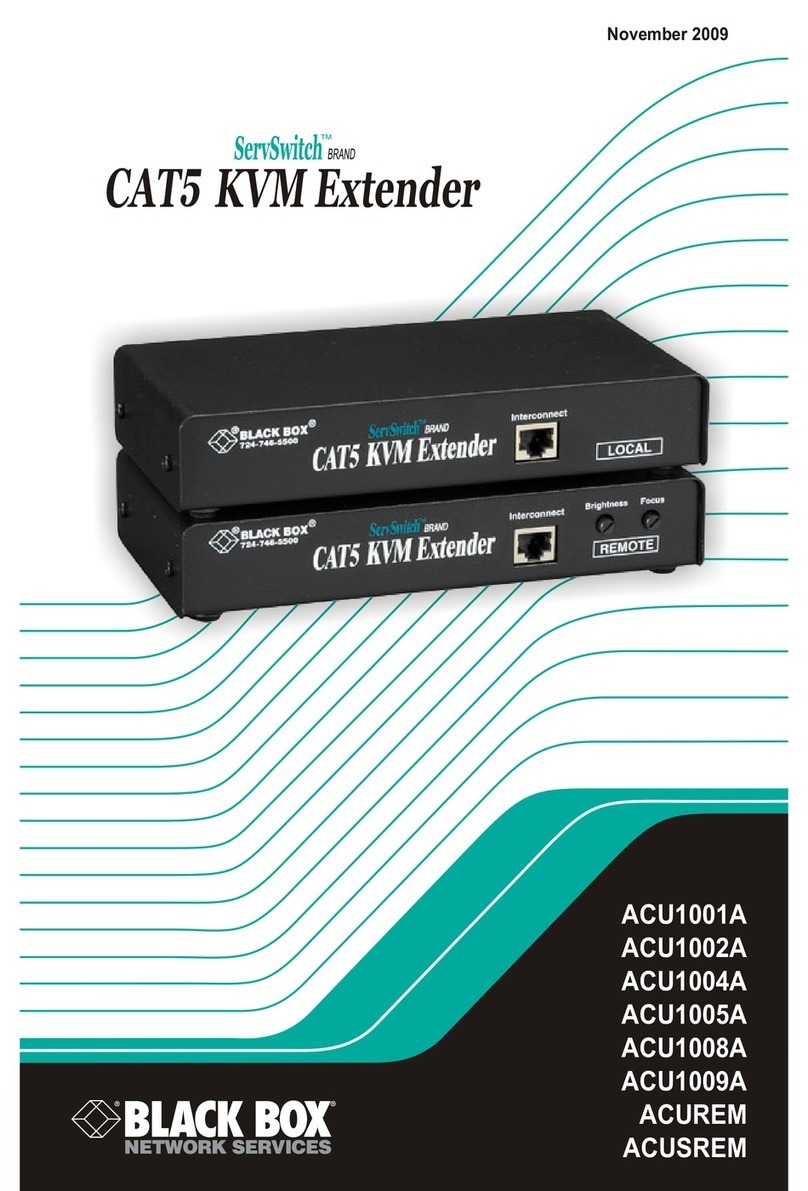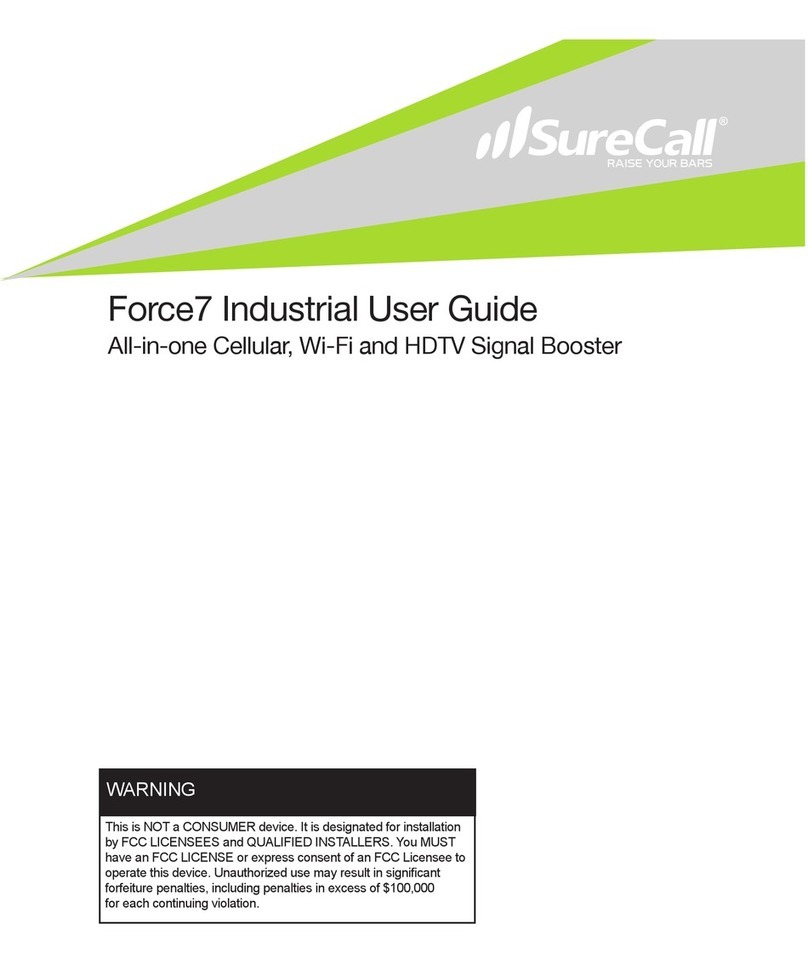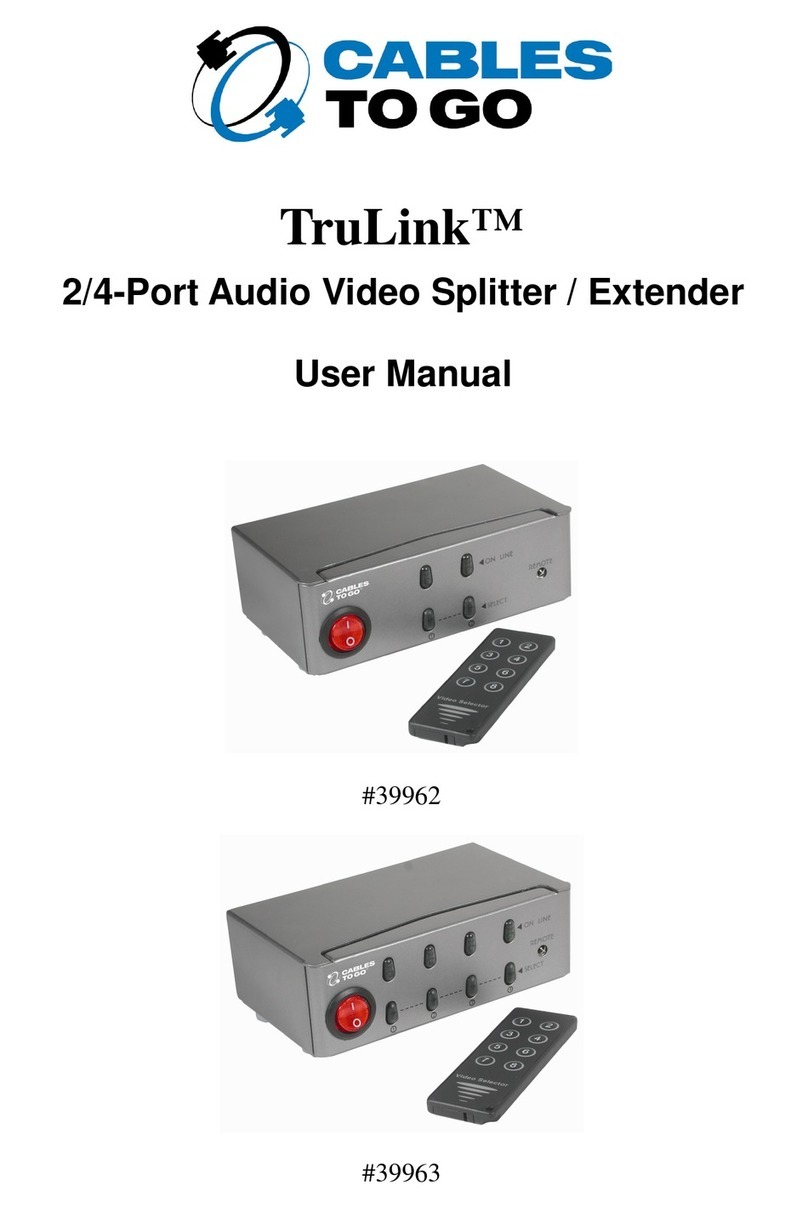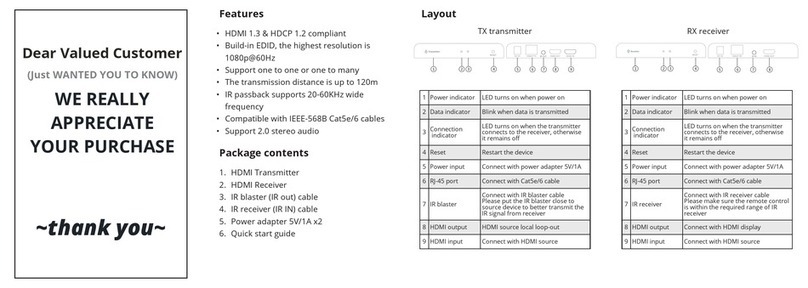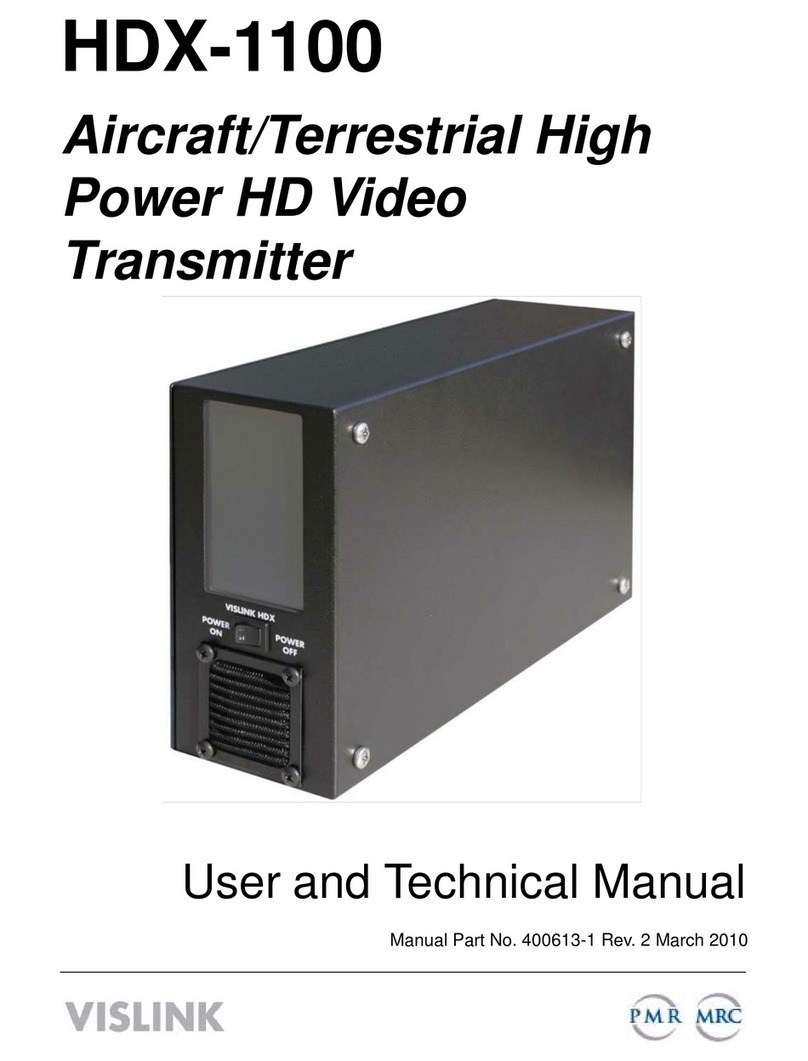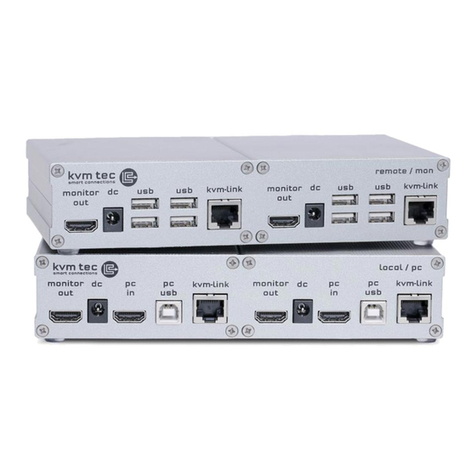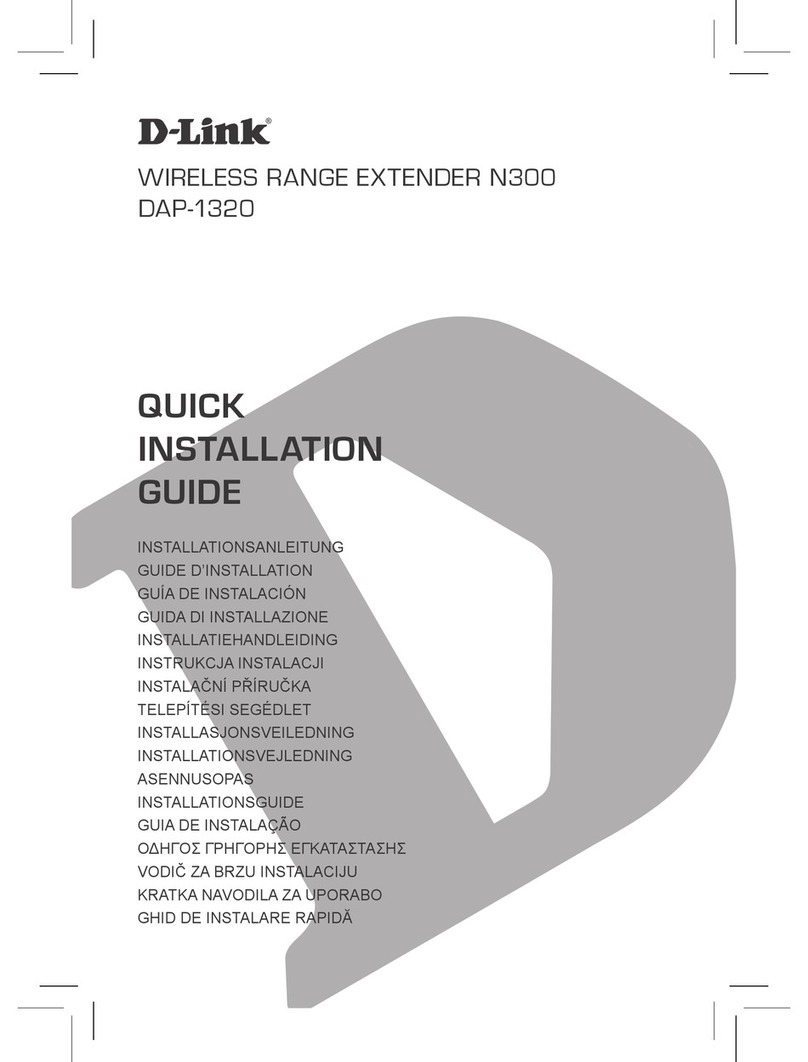ADTRAN T200 FNID Instruction Manual

161246041L3-5, Issue 161246041L3-5A
CONTENTS
1. GENERAL ...................................................................1
2. INSTALLATION...........................................................2
3. FACEPLATE FEATURES...........................................2
4. DEPLOYMENT GUIDE...............................................2
5. MAINTENANCE ..........................................................4
6. SPECIFICATIONS ......................................................5
7. WARRANTY AND CUSTOMER SERVICE ................5
Appendix A. HDSL Loopbacks............................................... A-1
FIGURES
Figure 1. ADTRAN T200 HRE ............................................. 1
Figure 2. HDSL Dep oyment Guide ines .............................. 2
Figure A-1. HDSL Loopback Points...................................... A-1
Figure A-2. HDSL E ement State Diagram ........................... A-2
TABLES
Table 1. Compliance Codes ..........................................2
Table 2. LED Indications ...............................................3
Table 3. Loop Insertion Loss Data ................................4
Table 4. ADTRAN HRE Specifications..........................5
Table A-1. HDSL Standard Loopback Control Codes ..A-3
Table A-2. HDSL Loopback Control Codes ..................A-5
Table A-3. Inband Addressable Loopback Codes ........ A-6
Section 61246041L3-5A
Issue 1, November 2000
CLEI Code # T1R6DJVD_ _
ADTRAN T200 Encapsulated HDSL Range Extender (HRE)
Installation and Maintenance
An HRE is used in conjunction with any span
powering T1 HDSL transceiver unit for the centra
office (HTU-C) and ow vo tage HDSL transceiver
unit for the remote end (HTU-R). Compatib e
ADTRAN HDSL transceiver units are as fo ows:
Part Number Description
1242002LX .......... 220/E220 HTU-C
1242016LX .......... 3192 HTU-C
1242023LX .......... DDM P us HTU-C
1244001LX .......... Low Vo tage 220/E220 HTU-C
1244002LX .......... Litespan HTU-C
1244021LX .......... Low Vo tage T200 HTU-R CP
1244022LX .......... Low Vo tage HTU-R SA
1245001LX .......... 5th Generation 220/E220 HTU-C
1245002LX .......... 5th Generation Litespan AHTIU
1245003LX .......... 5th Generation DDM P us HTU-C
1245004LX .......... 5th Generation 3192 HTU-C
1245021LX .......... 5th Generation T200 HTU-R CP
1245022LX .......... 5th Generation T200 HTU-R SA
1245024LX .......... 5th Generation T400 HTU-R
1245026LX .......... 5th Generation T200 HTU-R CI
1246001LX .......... 6th Generation 220/E220 HTU-C
1246003LX .......... 6th Generation DDM P us HTU-C
1246004LX .......... 6th Generation 3192 HTU-C
1246026LX .......... 6th Generation T200 HTU-R CI
1. GENERAL
The ADTRAN T200 Encapsu ated Low Vo tage HRE,
P/N 1246041L3, is used to extend the effective range
of an ADTRAN HDSL-based T1 circuit. Figure 1 is
an i ustration of the HRE. HRE equipment features
inc ude:
• Up to 12 kft of 24-gauge wire range in each direction
• 2B1Q ine coding
• Lightning protection
• In-band oopback contro
• Type 400 mechanics
• Enhanced provisioning, performance monitoring, and
diagnostics
The ADTRAN T400 Encapsu ated Low Vo tage HRE
can effective y doub e the dep oyment range of
standard HDSL and provide carrier service area
(CSA)-comp iant oops on both side of the HRE.
Using a centra y- ocated unit extends the digita
subscriber oop serving range up to 24 kft over
24-AWG twisted pair wire.
Trademarks: Any brand names and product names included in this document are
trademarks, registered trademarks, or trade names of their respective holders.
Figure 1. ADTRAN T200 HRE
HRE ENCAPSULATED
HDSL T1 RANGE EXTENDER
1246041L3
GREEN / WHITE
ORANGE / WHITE
BLUE / RED
BLUE / WHITE
BROWN / WHITE
SLATE / WHITE
HDSL LOOP 1 - NETWORK
HDSL LOOP 2 - NETWORK
HDSL LOOP 1 - CUSTOMER
HDSL LOOP 2 - CUSTOMER
NO CONNECTIONS
POWER
LOOP 1
LOOP 2
LOOP 1
LOOP 2
LPBK
GREEN=REM
AMBER=LOC
NET
CUST

2 61246041L3-5, Issue 1 61246041L3-5A
There are no manua option settings on the HRE.
HRE operating power is derived from an HTU-C,
independent of ine impedance or wire gauge. The
operating power from the HTU-C is a so used to span
power the Low Vo tage HTU-R.
Span power provided by the HTU-C to span power
the Low Vo tage HRE and Low Vo tage HTU-R is
ess than -140 Vdc or -190 Vdc if used in dua HRE
app ications. The span powering vo tage is within
imits of C ass A2 vo tages as defined by Be core
GR-1089-CORE.
The HRE operates at ine osses up to 35 dB at
196 kHz, in both directions from the extender and
regenerates the 2B1Q signa s to meet the transmitted
power spectrum of Be core TA-NWT-0001210.
Revision History
This is the first issue of this practice. In subsequent
issues, changes wi be summarized in this paragraph.
2. INSTALLATION
After unpacking the unit, inspect it for damage. If
damage is noted, fi e a c aim with the carrier, then
contact ADTRAN. See Warranty and Customer
Service.
The T200 Low Vo tage HRE Encapsu ated does not
require mounting in a repeater apparatus case.
Because it is encapsu ated in a po yurethane
compound, this device is weatherproof and can be
mounted on a po e, in a pedesta , in a manho e, or
other suitab e ocation.
Compliance Codes
Table 1 shows the Comp iance Codes for the T200
HRE. The T200 HRE comp ies with the requirements
covered under UL 1950, Third Edition, and is
intended to be insta ed in an enc osure with an
Insta ation Code (IC) of “B” or “E.”
3. FACEPLATE FEATURES
The ADTRAN Low Vo tage HRE facep ate has five
trico ored LEDs and one sing e co or LED indicating
different states of the HDSL circuit. Table 2 exp ains
the meaning of the different LED indications.
4. DEPLOYMENT GUIDELINES
The ADTRAN HDSL system is designed to provide
DS1-based services over oops designed to comp y
with Carrier Service Area (CSA) guide ines. CSA
dep oyment guide ines are given be ow.
1. A oops are non- oaded on y.
2. For oops with 26-AWG cab e, the maximum oop
ength inc uding bridged tap engths is 9 kft.
3. For oops with 24-AWG cab e, the maximum oop
ength inc uding bridged tap engths is 12 kft.
4. Any sing e bridged tap is imited to 2 kft.
5. Tota bridged tap ength is imited to 2.5 kft.
6. The tota ength of mu ti-gauge cab e containing
26-AWG cab e must not exceed:
12 - {(3*L26)/(9 - LBTAP)}(in kft)
L26 = Tota ength of 26-AWG cab e
exc uding bridged taps (in kft)
LBTAP = Tota ength of a bridged taps (in
kft)
This dep oyment criteria is summarized in the chart
shown in Figure 2.
C A U T I O N
C A U T I O N
!
SUBJECT TO ELECTROSTATIC DAMAGE
OR DECREASE IN RELIABILITY.
HANDLING PRECAUTIONS REQUIRED.
Code Input Output
Power Code (PC) C C
Te ecommunication Code (TC) X X
Insta ation Code (IC) A –
Table 1. Compliance Codes
Figure 2. HDSL Deployment Guidelines
0
12
11
10
9
8
7
6
5
4
3
2
1
01234
WORKING LENGTH OF 26 GAUGE CABLE (KFT)
WORKING LENGTH OF 24 GAUGE (OR COARSER) CABLE (KFT)
56789
2.5
INVALID HDSL CABLE LENGTHS
2.0 1.5 1.0 0.5 0.0
TOTAL
BRIDGED
TAPLENGTH
(KFT)
VALID HDSL CABLE LENGTHS

361246041L3-5, Issue 161246041L3-5A
LED Description and Indications
POWER .................... This LED indicates two states.
Off ........... No span power is present.
On ........... Span power is present.
NET LOOP 1 ........... ThisLEDindicatestheHDSLsignalquality,loopbackstatus,anderrorsonNETloop 1. The
NETLP1LEDwillflashoncewhenanerroredsecondisdetectedonNETloop1. IftheNET
LP1 LED flashes yellow rapidly (six times per second), sealing current is present and the
HRE is attempting to synchronize with the other HDSL circuit elements.
Off ........... No synchronization with the HTU-C.
Green ...... Synchronized with good signal quality on NET loop 1 (> 2 dB margin above
10-7 BER).
Yellow ..... Synchronized with marginal signal quality on NET loop 1 (≤2 dB margin above
10-7 BER).
Red .......... Synchronized with poor signal quality on NET loop 1 (≥10-7 BER).
NET LOOP 2 ........... This LED indicates the HDSL signal quality, loopback status, and errors on NET loop 2.
NET LP2 LED will flash once when an errored second is detected on NET loop 2.
Off ........... No synchronization with the HTU-C.
Green ...... Synchronized withgoodsignalquality on NETloop2 (> 2dBmargin above 10-7
BER).
Yellow ..... Synchronized with marginal signal quality on NET loop 2 (≤2 dB margin above
10-7 BER).
Red .......... Synchronized with poor signal quality on NET loop 2 (≥10-7 BER).
CUST LOOP 1 ......... This LED indicates HDSL signal quality, loopback status, and errors on CUST loop 1. It
will flash once when an errored second is detected on CUST loop 1.
Off ........... No synchronization with the HTU-R.
Green ...... Synchronized with good signal quality on CUST loop 1 (> 2 dB margin above
10-7 BER).
Yellow ..... SynchronizedwithmarginalsignalqualityonCUSTloop1(≤2dBmarginabove
10-7 BER).
Red .......... Synchronized with poor signal quality on CUST loop 1 (≥10-7 BER).
CUST LOOP 2 ......... This LED indicates HDSL signal quality, loopback status, and errors on CUST loop 2. It
will flash once when an errored second is detected on CUST loop 2.
Off ........... No synchronization with the HTU-R.
Green ...... Synchronized with good signal quality on CUST loop 2 (> 2 dB margin above
10-7 BER).
Yellow ..... SynchronizedwithmarginalsignalqualityonCUSTloop2(≤2dBmarginabove
10-7 BER).
Red .......... Synchronized with poor signal quality on CUST loop 2 (≥10-7 BER).
LPBK........................ This LED indicates HDSL loopback status.
Yellow ..... HRE network loopback is active.
Green ...... HRE customer loopback is active.
Operation of HRE LEDs during HRE Network Loopback:
NET LOOP 1 and LOOP 2................. Both of these LEDs will flash three times per second when the HRE
network loopback is active.
CUST LOOP 1 and LOOP 2 .............. If both of these LEDs are Off, there is no synchronization with the
HTU-R. If they are both on, the HRE is properly synchronized with the
HTU-R.
LPBK................................................... This LED will be Yellow when an HRE network loopback is active.
Operation of HRE LEDs during HRE Customer Loopback:
NET LOOP 1 and LOOP 2 ................. If both of these LEDs are Off, there is no synchronization with the HTU-C.
If they are both on, the HRE is properly synchronized with the HTU-C.
CUST LOOP 1 and LOOP 2 .............. Both of these LEDs will flash three times per second when the HRE
customer loopback is active.
LPBK................................................... This LED will be Green when an HRE customer loopback is active.
Table 2. LED Indications
Faceplate LEDs Indicate the Following HRE States
POWER
LOOP 1
LOOP 2
LOOP 1
LOOP 2
LPBK
GREEN=REM
AMBER=LOC
NET
CUST

4 61246041L3-5, Issue 1 61246041L3-5A
Recommended maximum oca oop oss information
for PIC cab e at 70° F and 135 Ω resistive termination
is provided in Table 3.
An approximation for the maximum amount of
wideband noise on a DSL oca oop as measured by a
50 kbps fi ter is ≤31 dBrn.
An approximation for the maximum eve of impu se
noise as measured using a 50 kb fi ter on an DSL oop
is ≤50 dBrn.
NOTE
These approximations are to be used as guide ines
on y and may vary s ight y on different oops.
Adhering to the guide ines shou d produce
performance in excess of 10-7 BER.
5. MAINTENANCE
The ADTRAN Low Vo tage HRE requires no routine
maintenance. In case of equipment ma function,
perform an in-band oopback from the centra office
(CO), as defined in Appendix A. If a ma function is
confirmed, rep ace the HRE.
The HRE has ooping capabi ity through the channe
a owing digita oopback in fau t iso ation. The
ooping is accomp ished remote y from the CO switch
as defined in the tab e in Appendix A.
Performance monitoring, diagnostics, and oopbacks
are a so avai ab e from the craft interface at the
HTU-C and HTU-R.
When testing indicates a fau ty circuit pack, refer to
the housing insta ation/maintenance practice for the
entry and pressurization contro , then rep ace the
fau ty circuit pack.
An in-band oopback test can be performed from the
CO (see Appendix A).
ADTRAN does not recommend fie d repair of the
circuit pack. Repair services may be obtained by
returning the defective unit to the ADTRAN Repair
Department.
Table 3. Loop Insertion Loss Data
3,000...................
10,000..................
50,000..................
100,000..................
150,000..................
200,000..................
250,000..................
325,000..................
Frequency
(Hz)
12.0
15.0
25.5
30.0
32.75
35.25
37.25
42.00
Maximum Loss
(dB)

561246041L3-5, Issue 161246041L3-5A
6. SPECIFICATIONS
Table ists the ADTRAN HRE specifications.
7. WARRANTY AND CUSTOMER SERVICE
ADTRAN wi rep ace or repair this product within 10
years from the date of shipment if it does not meet its
pub ished specifications or fai s whi e in service (see
ADTRAN Carrier Networks Equipment Warranty,
Repair, and Return Policy and Procedure, document
60000087-10A).
Contact Customer and Product Service (CAPS) prior
to returning equipment to ADTRAN. For service,
CAPS requests, or further information, contact one of
the fo owing numbers:
ADTRAN Sales
Pricing/Avai abi ity
(800) 827-0807
ADTRAN Technical Support
Presa es App ications/Postsa es Technica Assistance
(800) 726-8663
Standard hours: Monday-Friday, 7 a.m. - 7 p.m. CST
Emergency hours: 7 days/week, 24 hours/day
ADTRAN Repair/CAPS
Return for Repair/Upgrade
(256) 963-8722
Repair and Return Address
ADTRAN, Inc.
CAPS Department
901 Exp orer Bou evard
Huntsvi e, A abama 35806-2807
Loop Interface
Modu ation Type.................................... 2B1Q
Mode ...................................................... Fu dup ex, echo cance ing
Number of Pairs ..................................... Two
Bit Rate .................................................. 784 kbps per pair
Baud Rate ............................................... 392K baud per pair
Service Range ........................................ Defined by CSA guide ines
Loop Loss............................................... 36 dB maximum @ 200 kHz
Bridged Taps .......................................... Sing e taps < 2 kft, tota taps < 2.5 kft
Performance ........................................... Comp iant with Be core TA-NWT-001210
Return Loss ............................................ 20 dB (40 kHz to 200 kHz)
HDSL Tx Signa Leve .......................... 13.5 dBm
Input Impedance .................................... 135 Ω
DS1 Channe ization ............................... Channe s 1-12 on Loop 1, Channe s 13-24 on Loop 2
Power
Input Power ............................................ (span-powered by HTU-C) 3.5 watts,maximum
Tests
Diagnostics ............................................. Loopback initiated with HDSL in-band codes or from HTU-C or HTU-R craft interface.
Physical
Dimensions ............................................ 1.5" high x 6.0" wide x 6.0" deep
Weight .................................................... < 1 b.
Environment
Temperature ........................................... Operating (Standard): -40° to +70° C; Storage: -40° to +85° C
Re ative Humidity .................................. Up to 95%, non-condensing
Table 4. ADTRAN HRE Specifications

6 61246041L3-5, Issue 1 61246041L3-5A

A-161246041L3-5, Issue 161246041L3-5A
Appendix A
HDSL LOOPBACKS
This appendix describes the use and operation of
oopback contro code sequences used in ADTRAN’s
HDSL system. Loopback contro codes are governed
by the HTU-C (and HRE(s) if dep oyed). Two types
of HTU-Cs exist which enab e two different sets of
oopback codes—Standard or Enhanced oopbacks.
The Standard oopbacks are those that have been
contained in ADTRAN’s HDSL product fami y
beginning with 2nd Generation products. The
Enhanced oopbacks are contained in se ected
ADTRAN HTU-C units. The fo owing tab e denotes
whether the HTU-C (part number) contains Standard
or Enhanced oopback capabi ities.
Standard Loopback
Part Number Description
1242002Lx .............. 220/E220 HTU-C
1242016L1 .............. 3192 HTU-C
1242023L1 .............. DDM+ HTU-C
1244001L1 .............. E220/220 Low Vo tage T1 HTU-C
1244002L1-L3 ........ Litespan AHDSL
1244002L4-L6 ........ Litespan AHT1U
1245001L1 .............. 5th Generation E220/220 Low
Vo tage HTU-C
1245001L2 .............. 5th Generation E220/220
HTU-C M
1245003L1 .............. 5th Generation DDM+HTU-C
1245004L1 .............. 5th Generation 3192 HTU-C
Enhanced Loopback
Part Number Description
1245001L4 ............... 5th Generation 220/E220 HTU-C
1245003L4 ............... 5th Generation DDM+ HTU-C
1245004L4 ............... 5th Generation 3192 HTU-C
1245002L6 ............... 5th Generation Litespan AHTIU
1246001L4 ............... 6th Generation 220/E220 HTU-C
1246003L4 ............... 6th Generation DDM+ HTU-C
1246004L4 ............... 6th Generation 3192 HTU-C
The HREs and HTU-Rs’ oopback capabi ities are
contro ed from the centra office unit (HTU-C).
NOTE
If the HTU-C on a circuit contains Standard
oopbacks, then refer to subsection 1 of this
appendix to determine its capabi ities. If the
HTU-C on a circuit contains Enhanced
oopbacks, then refer to subsection 2 of this
appendix to determine its oopback capabi ities.
1. STANDARD LOOPBACKS
This subsection describes operation of the HDSL
system in detection of in-band and ESF faci ity data
ink oopback codes. The operation of the oopback
commands in the ADTRAN HDSL system is
comp iant with the recommendation to ANSI recorded
in T1E1.4/92. The HDSL network oopback points
described be ow are shown in Figure A-1.
HTU-C oopback is a regenerative oopback of the
DSX-1 signa toward the network.
HTU-R oopback is a regenerative oopback of the
DS1 signa toward the network. This oopback is in
addition to a separate Smartjack oopback. Separate
activation sequences are provided for the HTU-R and
the Smartjack oopback initiation. The HDSL
oopbacks are imp emented such that the downstream
HDSL e ements (toward the customer) remain
synchronized.
Upon deactivation of a oopback, the HDSL system
wi synchronize automatica y. It shou d be noted
that the synchronization process of the HDSL system
upon deactivation of the HRE oopback, cou d take up
to 15 seconds to ensure a system e ements are
synchronized.
Figure A-1. HDSL Loopback Points
HTU-C HTU-R NIU
HDSL REPEATER
DSX-1
Interface HDSL
Loops HDSL
Loops DS1
Interface

A-2 61246041L3-5, Issue 1 61246041L3-5A
Loopback Process
In genera , the oopback process for the HDSL system
e ements is mode ed on the corresponding DS1 system
process. Specifica y, the HTU-C oopback is simi ar
to an inte igent office repeater oopback and the
HTU-R oopbacks are simi ar to an in ine T1 repeater
oopback.
Each HDSL system e ement is independent y
described by the state diagram shown in Figure A-2.
The four states are disarmed, oop-up, armed, and
oop-up/no timeout.
State transitions resu t from in-band, ESF data ink
sequences, and timeout operations. The sequences
and timeouts are as fo ows:
• Arming (in-band and ESF)
• Activation
• Deactivation
• Disarming (in-band and ESF)
• Loop-up Timeout
• Arming Timeout
Figure A-2. HDSL Element State Diagram
LOOPUP/TIMEOUT
STATE
ARMED
STATE
LOOPUP/NO TIMEOUT
STATE
DISARMED
STATE
ACTIVATION LOOPUP
TIMEOUT
ARMING
TIMEOUT
DEACTIVATION DISARM
LOOPUP
TIMEOUT
DISABLE*
*The Loopup Timeout Disable function is currently not supported.
A summary of timeout and contro sequences is given
in Table A-1.
In-band contro code sequences are transmitted over
the DS1 ink by either the unframed or overwrite
method. The HDSL e ements respond to either
method.
The unframed method produces periodic contro
sequences, and the norma DS1 framing bit is omitted.
The overwrite method produces periodic contro
sequences. However, once per frame, the framing bit
overwrites one of the bits in the contro sequence.
The unit can detect the oopback activation or
deactivation code sequence only if an error rate of
1E-03 or better is present.
NOTE
In a contro code sequences presented, the
in-band codes are shown eftmost bit transmitted
first, and the ESF data ink codes with rightmost
bit transmitted first.

A-361246041L3-5, Issue 161246041L3-5A
Disarmed State
The disarmed state is the norma mode of operation.
Each HDSL e ement is transparent to the data f ow.
However, the in-band data f ow and the ESF data ink
are monitored for the arming sequence.
The in-band contro code sequence used to
simu taneous y arm the oopback capabi ity of a
HDSL e ements is the standard 5-bit in-band sequence
used for NIU Smartjack oop-up. Each HDSL
e ement arms after receiving the fo owing code for
five seconds:
ARM SEQUENCE
11000 for five seconds
The arming process ensures unambiguous race-free
operation of HDSL e ement arming and Smartjack
oop-up. The HDSL unit can detect the sequence
without interfering with the detection by the
Smartjack. Present y, the Smartjack oop-up response
requires a duration of at east five seconds. The
objective of the HDSL detection scheme is to arm the
HDSL e ements without interfering with the
Smartjack oop-up.
The requirement imposed on the arm sequence is that
the Smartjack shou d oop-up and a HDSL e ements
make a transition from the disarmed state into the
armed state. A other contro code sequences are
ignored in the disarmed state.
The ESF data ink sequence used to simu taneous y
arm the oopback capabi ity of a HDSL e ements is
the standard 16-bit ESF data ink sequence used for
NIU Smartjack oop-up.
ESF ARM SEQUENCE
0001 0010 1111 1111
for four repetitions
Race-free operations of the HDSL e ement arming and
Smartjack oop-up is accomp ished as described for
the in-band code. For examp e, the ESF arm sequence
causes the Smartjack to oop-up and a of the HDSL
e ements to move from the disarmed state into the
armed state. A other ESF data ink contro code
sequences are ignored in the disarmed sate.
Armed State
In the armed state, the HDSL system e ement
continues to be transparent to data f ow. However, the
in-band data f ow is monitored for the activation and
disarming sequences. The ESF data ink is monitored
for the disarming sequence.
Table A-1. HDSL Standard Loopback Control Codes
Name
Arming (In-band)
Arming (ESF)
Activation
(HTU-C)
Activation
(HDSL Range Extender)
Activation
(HTU-R)
Deactivation
(all HDSL elements)
Disarming (In-band)
Disarming (ESF)
Arming Timeout
Loop-up Timeout
Detection Time
5 Seconds
4 Repetitions
> 4 Seconds
> 4 Seconds
> 4 Seconds
> 5 Seconds
5 Seconds
4 Repetitions
2 Hours
Programmable from
HTU-C:
None, 20, 60,
or 120 minutes
Code
11000
0001 0010 1111 1111
1101 0011 1101 0011
1100 0111 0100 0001
1100 0111 0100 0010
1001 0011 1001 0011
11100
0010 0100 1111 1111
N/A
N/A
Comments
Signal sent in-band or over ESF data link.
HDSL elements in disarmed state make
transition to armed state. Detection of either
code results in Smartjack loop-up, if NIU
loopback is enabled.
Signalsentin-band. HDSLelementsinarmed
state make transition to loop-up state.
Loop-upstatetimeoutisprogrammable from
the HTU-C.
Signalsentin-band. HDSLelementinloop-up
state makes transition to armed state.
Signal sent in-band or over ESF data link.
HDSLelementsinanystatemaketransition.
HDSLelementsinarmedstatemaketransition
to disarmed state.
HDSL element in loop-up makes transition to
armed state.

A-4 61246041L3-5, Issue 1 61246041L3-5A
A other in-band and ESF data ink contro code
sequences are ignored in the armed state. An arming
timeout va ue causes automatic return to the disarmed
state.
Transition from armed to loop-up state: An
in-band contro code sequence is used to command a
specific HDSL e ement to move from the armed state
into the oop-up state. Each HDSL e ement has a
unique 16-bit activation contro code sequence as
shown in the fo owing examp e:
HTU-C ACTIVATION SEQUENCE
101 0011 1101 0011
HTU-R ACTIVATION SEQUENCE
1100 0111 0100 0010
The designated HDSL e ement wi oop-up after
receiving the proper activation sequence.
Transition from armed to disarmed state:
A HDSL e ements can be commanded to move from
the armed state into the disarmed state by the standard
5-bit in-band disarming sequence used for NIU
Smartjack oop-down. Each HDSL e ement must
disarm after receiving the fo owing code for five
seconds:
DISARM SEQUENCE
11100
The disarming process ensures race-free operation of
HDSL e ement disarming and Smartjack oop-down.
Duration of the disarm sequence may need to exceed
24 seconds to a ow detection and oop-down of up to
three HDSL e ements and the Smartjack.
A HDSL e ements can be commanded to move from
the armed state into the disarmed state by the ESF
DATA LINK disarming sequence used for NIU
Smartjack oop-down as fo ows:
ESF DISARM SEQUENCE
0010 0100 1111 1111 for four
repetitions per e ement in
oopback
The disarming process ensures race-free operation of
HDSL e ement disarming and Smartjack oop-down.
Duration of the disarm sequence may need to exceed
16 repetitions to a ow detections and oop-down of up
to three HDSL e ements and the Smartjack. This
sequence wi oop-down the Smartjack and the HDSL
e ement.
A HDSL e ements wi automatica y move from the
armed state into the disarmed state when a defau t
timeout va ue of two hours is reached.
ARMING TIMEOUT
2 Hours
Loop-up State
In the oop-up state, the se ected HDSL e ement
provides continuous oop-up of the DS1 signa .
However, the data f ow is monitored for the in-band
deactivation sequence, the in-band disarming
sequence, and the ESF data ink disarming sequence.
A so, a oop-up timeout va ue causes automatic return
to the armed state. A other contro code sequences
are ignored in the oop-up state.
Transition from loop-up to armed state:
Any HDSL e ement can be commanded to move from
the oop-up state into the armed state by a sing e
in-band 16-bit deactivate contro code sequence. The
same deactivation sequence as shown is used for a
HDSL e ements.
DEACTIVATION
after receiving sequence for >5 seconds
Duration of the deactivation sequence may need to
exceed 18 seconds to a ow detection and oop-down
of up to three HDSL e ements. The deactivation
sequence does not disarm the HDSL e ements. They
can sti respond to activation sequence contro codes.
A HDSL e ements automatica y move from the
oop-up state into the armed state when the se ected
oop-up timeout va ue is reached.
LOOP-UP TIMEOUT
programmab e from HTU-C at
None, 20, 60, or 120 minutes
Transition from loop-up to disarmed state:
A HDSL e ements can be simu taneous y
commanded to move from the oop-up state into the
disarmed state by either the standard 5-bit in-band
disarming sequence used fro NIU Smartjack
oop-down, or by the ESF DATA LINK command, as
previous y described.
2. ENHANCED LOOPBACKS
HDSL Maintenance Modes
This subsection describes operation of the HDSL
system with regard to detection of in-band and ESF
faci ity data ink oopback codes.

A-561246041L3-5, Issue 161246041L3-5A
Upon deactivation of a oopback, the HDSL system
wi synchronize automatica y. Note that the
synchronization process of the HDSL system upon
deactivation of the HRE oopback cou d take up to 15
seconds, ensuring a system e ements are
synchronized.
Loopback Process Description
In genera , the oopback process for the HDSL system
e ements is mode ed on the corresponding DS1 system
process. Specifica y, the HTU-C oopback is simi ar
to an Inte igent Office Repeater oopback and the
HTU-R oopbacks are simi ar to an in- ine T1
Repeater oopback.
In-band contro code sequences are transmitted over
the DS1 ink by either the un ramed or overwrite
method. The HDSL e ements respond to either
method.
The unframed method produces periodic contro
sequences and the norma DS1 framing bit is omitted.
The overwrite method produces periodic contro
sequences. However, once per frame, the framing bit
overwrites one of the bits in the contro sequence.
The unit can detect the oopback activation or
deactivation code sequence only if an error rate of
1E-03 or better is present.
DDS Latching Loopback Operation
If the unit is optioned for FT1 mode, then DDS
Latching Loopback operation is supported as
described in Be core TA-TSY-000077, Issue 3,
Section 5.1.3. The HTU-C and any HRE units which
are in the HDSL circuit are treated as Identica
Tandem Dataports and the HTU-R is treated as a
Different Tandem Dataport. For a comp ete
description of the DDS Latching Loopback codes,
refer to Be core TA-TSY-000077, Issue 3, Section
5.1.3.
Loopback Control Codes
A summary of contro sequences is given in
Table A-2 and Table A-3.
NOTE
In a contro code sequences presented, the
in-band codes are shown eft-most bit transmitted
first, and the ESF data ink codes with right-most
bit transmitted first.
Table A-2. HDSL Loopback Control Codes
epyTecruoSemaNedoC
detaiverbbA)0000111(7ni3.......)N(
)0001111(7ni4.......)N(
)000011(6ni2.......)N(
)000111(6ni3......)N(
)0111111(7ni6......)C(
)0011111(7ni5......)C(
)001111(6ni4......)C(
)011111(6ni5......)C(
.RUTHehtnikrowtendrawotkrowtenmorfatadkcabpooL
.CUTHehtnikrowtendrawotkrowtenmorfatadkcabpooL
.ERHtsrifnikrowtendrawotkrowtenmorfatadkcabpooL
.ERHdnocesnikrowtendrawotkrowtenmorfatadkcabpooL
.CUTHniremotsucdrawotremotsucmorfatadkcabpooL
.RUTHniremotsucdrawotremotsucmorfatadkcabpooL
.ERHtsrifniremotsucdrawotremotsucmorfatadkcabpooL
.ERHdnocesniremotsucdrawotremotsucmorfatadkcabpooL
mocseWE1FF......)N(
E1F3......)C(
40FF......)N(
60FF......)N(
40F3......)C(
60F3......)C(
20FF......)N(
20F3......)C(
)000001(6ni1......)N(
)LD-FSE(84FF......)N(
)001(3ni1..)C/N(
)LD-FSE(42FF..)C/N(
.CUTHtakrowtendrawotkrowtenmorfatadkcabpooL
.CUTHtaremotsucdrawotremotsucmorfatadkcabpooL
.1ERHtakrowtendrawotkrowtenmorfatadkcabpooL
.2ERHtakrowtendrawotkrowtenmorfatadkcabpooL
.1ERHtaremotsucdrawotremotsucmorfatadkcabpooL
.2ERHtaremotsucdrawotremotsucmorfatadkcabpooL
.RUTHtakrowtendrawotkrowtenmorfatadkcabpooL
RUTHtaremotsucdrawotremotsucmorfatadkcabpooL
.RUTHtakrowtendrawotkrowtenmorfatadkcabpooL
.RUTHtakrowtendrawotkrowtenmorfatadkcabpooL
.gnihtyrevenwodpooL
.gnihtyrevenwodpooL
asetacidni)N(na,epmaxeroF.morftneserasedocortnocehtecafretniehtfoedishcihwsetacidninmuocecruoSehT:setoN
.edocdecruosremotsucasetacidni)C(aeihwedocdecruoskrowten
LD-FSEdeebassenudnabnierasedocA
.nopudetcadnadetcetedebotmehtrofredronisdnoces5fomuminimaroftnesebtsumevobadetsisedocA

A-6 61246041L3-5, Issue 1 61246041L3-5A
Table A-3. Inband Addressable Loopback Codes
noitcnuFedoCesnopseR
MRA00011
sanwonkosa(
)nrettap5-ni-2a
ehtsdrawotpupooiwR-UTHehT:DELBANEKCABPOOLUIN
ehT.kcabpoosihtfotuserasatnesebiwsrorreroSIAoN.krowten
.MRAiwERHdnaC-UTH
MRASID00111
sanwonkosa(
)nrettap5-ni-3a
stinuehtfoynafI.etatsdemraehtmorfdevomereraERHdnaC-UTHehT
.nwodpooiwyeht,deviecersinrettap00111ehtnehwkcabpooniera
.stinuanoffonrutiwsDELKBLehT
PUPOOLKROWTENC-UTH3D3D
11001011(
)11001011
iwC-UTHeht,*kcabpoonierastinuondnademraneebevahstinuehtfI
5,tnesebiw)s1a(SIAfosdnoces2,krowtenehtsdrawotpupoo
ehtotnidetcejniebiwsrorretib132nehtdna,ssapiwatadfosdnoces
iwsrorre132,tnesebotseunitnocnrettapehtsagnosA.angis1-XSD
iwtinueht,devomersinrettapehtnehW.sdnoces02yrevedetcejnieb
tib132fonoitcejnieht,detatsniersinrettapehtfI.kcabpooniniamer
.savretnidnoces02taemuseriwsrorre
PUPOOLKROWTEN1ERH147C
11100011(
)10000010
pupooiwERHeht,demraneebevahstinueht,tneserpsiERHnafI
fosdnoces5,tnesebiw)s1a(SIAfosdnoces2,krowtenehtsdrawot
.angis1-XSDehtotnidetcejniebiwsrorretib01nehtdna,ssapiwatad
yrevedetcejniebiwsrorre01,tnesebotseunitnocnrettapehtsagnosA
.kcabpooniniameriwtinueht,devomersinrettapehtnehW.sdnoces02
02taemuseriwsrorretib01fonoitcejnieht,detatsniersinrettapehtfI
.savretnidnoces
PUPOOLKROWTEN2ERH457C
11100011(
)00101010
pupooiwERHeht,demraneebevahstinueht,tneserpsiERHdnocesafI
fosdnoces5,tnesebiw)s1a(SIAfosdnoces2,krowtenehtsdrawot
1-XSDehtotnidetcejniebiwsrorretib002nehtdna,ssapiwatad
ebiwsrorre002,tnesebotseunitnocnrettapehtsagnosA.angis
iwtinueht,devomersinrettapehtnehW.sdnoces02yrevedetcejni
tib002fonoitcejnieht,detatsniersinrettapehtfI.kcabpooniniamer
.savretnidnoces02taemuseriwsrorre
NWODPOOL3939
11001001(
)11001001
iwkrowtenehtsdrawotkcabpooniytnerrucstinuERHdnaC-UTHynA
.etatsdemraehtniattatoniwdnanwodpoo
KCABPOOLYREUQ5D5D
10101011(
)10101011
krowtennieraR-UTHro,ERH,C-UTHehtdnademraerastinuehtfI
ehtfonoitcetednopuangis1-XSDehtotnidetcejnierasrorre,kcabpoo
srorre,tnesebotseunitnocnrettapehtsagnosA.nrettapkcabpooyreuq
hcaedetcejnisrorreforebmunehT.sdnoces02yreveniagadetcejniera
ehtfidetcejnierasrorre132.kcabpoonisitinuhcihwnosdnepedemit
krowtennisiR-UTHehtfiemitata02,kcabpookrowtennisiC-UTH
.kcabpookrowtennisiERHehtfiemitata01dna,kcabpoo
EDIRREVOTUOEMITKCABPOOL6D5D
10101011(
)01101011
ebiwtuoemitkcabpooeht,tnessinrettapsihtdnademraerastinuehtfI
unemGNINOISIVORPehtnodetadpuebiwnoitpotuoemitehT.debasid
sagnosA.ENONot)trop232-SRehthguorhtebaweiv(R-UTHehtfo
stinuehtnehW.debasidniameriwtuoemiteht,demraniamerstinueht
ehterofebdahtieuavehtotnruteriwtuoemitkcabpooeht,demrasidera
.tnessawedoc6D5D
ELBASIDREWOPNAPS7676
11100110(
)11100110
stietavitcaediwC-UTHeht,tnessinrettapsihtdnademraerastinuehtfI
gnosA.)tneserpfi(ERHdnaR-UTHehtffogninrut,yppusrewopnaps
niameriwyppusrewopnapseht,tnesebotseunitnocnrettapehtsa
iwC-UTHeht,tnesgniebregnoonsinrettapehtnehW.debasid
stinuA.no)s(tinuetomerehtgninrut,yppusrewopnapsstietavitcaer
.etatsdepoonudnademrasidehtotnruterdnaniarteriw
.nopudetcadnadetcetedebotmehtrofredronisdnoces5fomuminimaroftnesebtsumevobadetsisedoca:etoN
.tneserasedocpupooERHroC-UTHehtnehwkcabpookrowtenniebnacR-UTHehtneht,debanesiUINfI*
Other manuals for T200 FNID
3
Table of contents
Other ADTRAN Extender manuals
